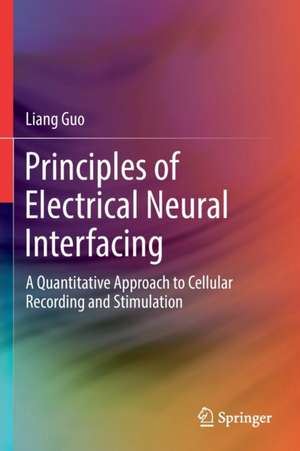Principles of Electrical Neural Interfacing: A Quantitative Approach to Cellular Recording and Stimulation
Autor Liang Guoen Limba Engleză Paperback – oct 2022
| Toate formatele și edițiile | Preț | Express |
|---|---|---|
| Paperback (1) | 426.15 lei 6-8 săpt. | |
| Springer International Publishing – oct 2022 | 426.15 lei 6-8 săpt. | |
| Hardback (1) | 590.82 lei 6-8 săpt. | |
| Springer International Publishing – 30 sep 2021 | 590.82 lei 6-8 săpt. |
Preț: 426.15 lei
Preț vechi: 448.58 lei
-5% Nou
Puncte Express: 639
Preț estimativ în valută:
81.54€ • 85.14$ • 67.34£
81.54€ • 85.14$ • 67.34£
Carte tipărită la comandă
Livrare economică 15-29 aprilie
Preluare comenzi: 021 569.72.76
Specificații
ISBN-13: 9783030776794
ISBN-10: 3030776794
Pagini: 169
Ilustrații: XX, 169 p. 49 illus., 32 illus. in color.
Dimensiuni: 155 x 235 mm
Greutate: 0.28 kg
Ediția:1st ed. 2022
Editura: Springer International Publishing
Colecția Springer
Locul publicării:Cham, Switzerland
ISBN-10: 3030776794
Pagini: 169
Ilustrații: XX, 169 p. 49 illus., 32 illus. in color.
Dimensiuni: 155 x 235 mm
Greutate: 0.28 kg
Ediția:1st ed. 2022
Editura: Springer International Publishing
Colecția Springer
Locul publicării:Cham, Switzerland
Cuprins
Introduction.- Equivalent Circuit Models of Neurons.- Recording Electrodes.- Stimulating Electrodes.- Intracellular Recording.- Extracellular Recording.- Extracellular Recording of Propagating Action Potentials.- Recording using Field-Effect Transistors.- Neural Recording using Nanoprotrusion Electrodes.- Recording using Tetrodes.- Intracortical Functional Neural Mapping Using an Integrated 3D Ultra-Density MEA.- Neuronal Stimulation.- Electrical Stimulation to Promote Neuronal Growth.- Applications.
Notă biografică
Dr. Liang Guo is an assistant professor in the Department of Electrical and Computer Engineering at The Ohio State University, Columbus, Ohio, USA. He received the B.E. degree in biomedical engineering from Tsinghua University, Beijing in 2004 and the Ph.D. degree in bioengineering from Georgia Institute of Technology, Atlanta, GA in 2011. Subsequently, he worked as a postdoctoral associate in the Langer Lab at Massachusetts Institute of Technology, Cambridge, MA. He started as an assistant professor of Electrical and Computer Engineering and Neuroscience in September 2013 at The Ohio State University. He has dived into the neuroengineering field since his sophomore year in college and has been passionate to adhere to this field through his Ph.D. and postdoc trainings. His primary research interests are in neural interface engineering and biocircuit engineering as applied to neuroscience and neural prosthetics. He has published over 30 journal papers and obtained five patents. Earlier,he had edited a Springer book Neural Interface Engineering: Linking the Physical World and the Nervous System. Among other honors, he was awarded the Defense Advanced Research Projects Agency (DARPA) Young Faculty Award in 2017, the National Science Foundation (NSF) Faculty Early Career Development (CAREER) Award in 2018, and the OSU College of Engineering Lumley Research Award in 2018.
Textul de pe ultima copertă
This textbook fills a gap to supply students with the fundamental principles and tools they need to perform the quantitative analyses of the neuroelectrophysiological approaches, including both conventional and emerging ones, prevalently used in neuroscience research and neuroprosthetics. The content grows out of a course on Neuroengineering and Neuroprosthetics, which the author has taught already several times. The key problems the author addresses include (1) the universal operating mechanisms of neuroelectrophysiological approaches, (2) proper configuration of each approach, and (3) proper interpretation of the resulting signals. Efforts are made both to extract the universal principles underlying this common class of approaches and discern the unique properties of each individual approach. To address these important problems, equivalent electrical circuit modeling and signal analysis are used to unravel the functioning mechanisms and principles and provide sound interpretations to the associated signals and phenomena. This book aims to derive analytical solutions to these equivalent circuits, which can offer clear and complete mechanistic insights to the underlying biophysics.
Caracteristici
Offers textbook coverage of the neuroelectrophysiological approaches prevalently used in neuroscience research and neuroprosthetics, including the most significant and exciting developments over the past decade Provides sufficient breadth and depth in a logical and stepwise manner Employs equivalent electrical circuit modeling and signal analysis to derive analytical solutions Offers clear and complete mechanistic insights to the underlying biophysics and functioning principles Provides sound interpretations of the resulting signals and phenomena Informs the proper usage and development of this class of important tools
